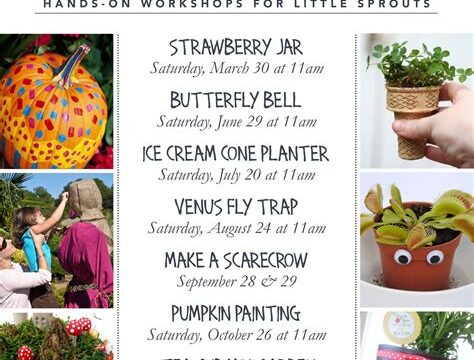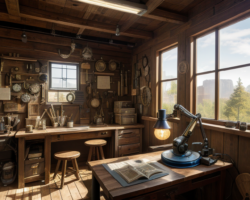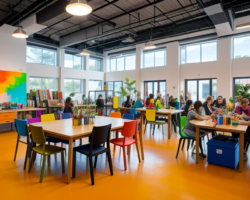DIY Science Experiment: Exploring Volcanoes
Volcanoes have always fascinated humans with their raw power and unpredictable nature. If you’re looking for a hands-on science experiment that will ignite your curiosity, then exploring volcanoes through a DIY experiment is the perfect project for you. Not only will you learn about the geological processes behind volcanic eruptions, but you will also have the opportunity to witness the explosive forces of nature right in your own home.
First, let’s gather the materials you will need for this experiment. You will need a baking soda, vinegar, a plastic bottle, food coloring, dish soap, and a tray or container to catch any spills. Once you have all the materials, you are ready to create your own volcanic eruption.
Start by placing the plastic bottle in the center of the tray or container. This will help contain the eruption and prevent a messy cleanup. Next, add about two tablespoons of baking soda into the bottle. Baking soda is a key ingredient in this experiment as it will create the volcanic eruption when combined with vinegar.
Now, it’s time to add some excitement to your volcano. Add a few drops of your favorite food coloring into the bottle. This will give your eruption a visually stunning effect. You can choose a color that resembles real lava or go wild with bright and vibrant hues. The choice is yours!
Lastly, add a few drops of dish soap into the bottle. The dish soap will create bubbles in the eruption, mimicking the frothy appearance of real volcanic lava. It will also help to enhance the overall effect and make your experiment even more captivating.
Once you have prepared all the components, it’s time to make the volcano come to life. Carefully pour vinegar into the bottle, making sure not to overflow. As soon as the vinegar reacts with the baking soda, a chemical reaction occurs, releasing carbon dioxide gas. This gas creates pressure inside the bottle, causing the mixture to shoot out in a volcano-like eruption.
As you watch the eruption unfold, pay close attention to the fascinating processes at work. The baking soda and vinegar mixture represents the interaction between volcanic magma and volcanic gases in real-life volcanic eruptions. The released carbon dioxide gas forms bubbles, creating the explosive force that propels the mixture out of the bottle.
After the eruption subsides, take a moment to reflect on what you have witnessed. Volcanoes are not only breathtaking natural wonders but also provide valuable insights into the inner workings of our planet. By exploring volcanoes through this DIY science experiment, you have gained a deeper understanding of their power and the scientific principles that govern their behavior.
Creative Crafts: Making Personalized Friendship Bracelets
Are you looking for a fun and creative activity to do with your friends? Making personalized friendship bracelets is the perfect craft project that allows you to showcase your creativity and create a unique piece of jewelry. Whether you want to make matching bracelets for your squad or create individualized designs for each of your friends, this craft is a fantastic way to strengthen the bond between you and your friends.
First, gather all the necessary materials for your friendship bracelet project. You will need different colored embroidery floss, scissors, and a tape measure or ruler. The embroidery floss comes in a variety of colors, so choose the ones that best represent your personal style or the preferences of your friends. Once you have everything you need, it’s time to start crafting!
To begin, measure the length of the bracelet by wrapping the floss around your wrist and adding a few extra inches for tying the ends. Cut as many strands of floss as you desire for your bracelet. For a single-colored bracelet, you can use two to three strands, but feel free to experiment with more colors and layers to create a more intricate design.
Next, gather all the strands together, making sure they are aligned at one end. Tie a knot at the top, leaving a small loop at the top for fastening the bracelet later. You can secure the friendship bracelet to a clipboard or tape it to a table to keep it steady while you work.
Now comes the fun part – the braiding! Separate the strands into two groups and cross the right group over the left group, forming a number “4” shape. Take the right strand underneath the left strands and pull it through the loop created by the “4”. Continue this pattern, alternating which group goes over the other. As you continue braiding, you will notice the bracelet taking shape, with a beautiful interweaving of colors.
Once you have reached the desired length for your bracelet, secure the end by tying a knot. You can add decorative beads or charms to the ends of the bracelet for an extra personal touch. Trim any excess floss, and your personalized friendship bracelet is ready to wear or gift to a friend!
Making personalized friendship bracelets is not only a great way to express your creativity but also a wonderful way to show someone how much they mean to you. These handmade bracelets carry sentimental value and can be a constant reminder of the special bond you share with your friends. So gather your supplies, get crafty, and start making beautiful friendship bracelets that will be cherished by you and your friends for years to come!
Keywords: creative crafts, personalized friendship bracelets, craft project, jewelry, embroidery floss, colors, design, braiding, handmade bracelets, special bond
Interactive Storytelling: Creating and Performing Puppet Shows
Introduction: Welcome to the world of interactive storytelling! In this blog post, we will delve into the exciting realm of puppet shows and explore the art of creating and performing with puppets. Puppet shows have been a cherished form of entertainment for centuries, captivating audiences of all ages. From traditional hand puppets to modern-day marionettes, puppets are a powerful storytelling tool that allows us to bring characters to life and engage our audience in a truly unique and interactive way.
Benefits of Puppet Shows: Puppet shows offer a myriad of benefits for both the performers and the audience. They provide a creative outlet for storytelling, enabling individuals to express their imagination and creativity. Puppetry also helps develop essential skills such as communication, problem-solving, and coordination. For the audience, puppet shows promote active listening, enhance concentration, and stimulate visual and auditory senses. With the ability to interact with the puppets and participate in the story, the audience becomes an integral part of the narrative, fostering engagement and active learning.
Creating and Performing: Now, let’s dive into the exciting process of creating and performing a puppet show! The first step is to decide on a story or theme for your show. It can be an original tale or a retelling of a beloved fable. Once you have your story, it’s time to design and create your puppets. You can use a variety of materials such as fabric, cardboard, or even socks to craft your puppet characters. Let your imagination run wild as you give each puppet its own unique personality and features.
Next, consider the setting and props for your show. You can create a miniature stage using a cardboard box or a curtain hung between two chairs. Add colorful backdrops, props, and scenery to bring your story to life. It’s important to ensure that the stage is well-lit so that the audience can see the puppets clearly.
Now comes the most thrilling part – the performance! Practice bringing your puppets to life by manipulating them with precision and expressing their emotions through movement. Performances can be scripted or improvisational, depending on your preference. Engage with your audience by encouraging their participation, asking questions, or even inviting them to join in as puppeteers.
Conclusion: Interactive storytelling through puppet shows is a magical and captivating experience. By creating and performing with puppets, we unlock our creativity, engage our audience, and transport them into enchanting worlds of imagination. Whether it’s a small gathering of friends or a large-scale production, the art of puppetry allows us to communicate stories, emotions, and lessons in a fun and interactive way. So, gather your materials, unleash your inner storyteller, and embark on a delightful journey of puppetry and interactive storytelling!
- Benefits of Puppet Shows:
- Expression of imagination and creativity
- Development of communication and problem-solving skills
- Promotion of active listening and concentration
- Stimulation of visual and auditory senses
- Enhancement of engagement and active learning
| Steps for Creating and Performing Puppet Shows: |
|---|
| 1. Decide on a story or theme |
| 2. Design and create puppet characters |
| 3. Create the stage and set the props |
| 4. Practice manipulating puppets and expressing emotions |
| 5. Engage with the audience and encourage participation |
Outdoor Adventure: Building a Miniature Garden
Building a miniature garden is a perfect outdoor adventure that allows you to unleash your creativity and connect with nature. Whether you have a spacious backyard or a small balcony, creating a miniature garden can be a fun and rewarding project. Not only does it add beauty and charm to your outdoor space, but it also provides a calming and therapeutic experience. In this blog post, we will explore the steps to build a miniature garden and some creative ideas to make it truly unique.
To start your outdoor adventure of building a miniature garden, you will need some basic materials such as a container or tray, potting soil, small plants, and decorative elements like figurines or pebbles. The first step is to choose a suitable container for your garden. It can be a shallow dish, a wooden box, or even an upcycled item like an old teapot or a fountain. Make sure your container has drainage holes to prevent water from pooling.
Next, fill your container with potting soil, leaving some space at the top for your plants. You can use a mix of regular potting soil and cactus soil for better drainage. Once the soil is in place, it’s time to plan the layout of your miniature garden. Consider the size and shape of your container and arrange the plants accordingly. You can choose small succulents, herbs, or flowering plants that thrive in containers.
- Place the taller plants towards the back or center of the container to create depth.
- Use trailing plants or moss to cover the edges and create a natural look.
- Add different textures and colors to make your garden visually appealing.
After positioning your plants, it’s time to add some creative and decorative elements. This is where you can let your imagination run wild. Consider adding miniature furniture, tiny figurines, small rocks, or seashells to add interest and personality to your garden. You can also use pebbles or decorative rocks to create pathways or borders within the garden.
| Materials needed: | Steps to follow: |
|---|---|
| Container or tray | 1. Choose a suitable container with drainage holes. |
| Potting soil | 2. Fill the container with potting soil, leaving space at the top. |
| Small plants | 3. Plan the layout and position the plants in the container. |
| Decorative elements | 4. Add creative and decorative elements like figurines or rocks. |
Once you have completed the construction of your miniature garden, it’s important to take care of it. Make sure to water the plants regularly, but be cautious not to overwater them as it can lead to root rot. Place your garden in a location that receives adequate sunlight or shade depending on the plants you have chosen.
Building a miniature garden is not only about the end result but also about the process. It allows you to connect with nature, utilize your imagination, and create a unique outdoor space. So, gather your materials, get your hands dirty, and embark on an exciting outdoor adventure by building your own miniature garden.
Innovative Engineering: Constructing Paper Airplanes
Constructing paper airplanes is not only a fun and engaging activity, but it also involves the principles of innovative engineering. This simple yet fascinating hobby allows you to explore the art of flight and experiment with different designs to achieve optimal performance. Whether you are a beginner or an experienced paper airplane enthusiast, there are endless possibilities for creating unique and aerodynamic models.
When it comes to constructing paper airplanes, there are a few key factors to consider, such as the type of paper, the design, and the folding technique. Choosing the right type of paper is essential for achieving the desired balance between weight and durability. While regular printer paper is a good starting point, you may want to experiment with different types of paper, such as origami paper or lightweight cardstock, to find the perfect fit for your airplane.
The design of your paper airplane plays a crucial role in its flight performance. There are numerous designs to choose from, ranging from simple darts to more complex gliders. You can find plenty of design templates and tutorials online to help you get started, or you can let your creativity soar by coming up with your own unique designs. Experimenting with different shapes, wing sizes, and tail configurations will allow you to discover how they affect the aircraft’s stability and distance traveled.
The folding technique is another important aspect of constructing paper airplanes. Precision and accuracy in your folds will greatly impact the aerodynamics of the finished product. It is recommended to use a ruler or bone folder to achieve crisp and clean folds. Following the instructions carefully and taking your time during the folding process will ensure that your paper airplane is structurally sound and ready for flight.
Once you have constructed your paper airplane, it’s time to put it to the test. Find an open space, preferably outdoors, and give it a gentle throw. Observe how the airplane glides through the air and make note of any adjustments that may be needed. You can experiment with different launching techniques, angles, and even add small weights to the aircraft to see how they affect its flight characteristics.
Constructing paper airplanes not only provides hours of entertainment, but it also sparks curiosity and fosters creativity. It is an activity that combines art and science, allowing you to explore the principles of innovative engineering in a hands-on and exciting way. So, grab some paper, get folding, and let your imagination take flight!
Discovering Nature: Creating Eco-friendly Bird Feeders
Creating eco-friendly bird feeders is a wonderful way to connect with nature and attract beautiful birds to your backyard. Not only do bird feeders provide essential nourishment for our feathered friends, but they also offer the opportunity for us to observe and appreciate the diverse bird species that inhabit our environment. In this blog post, we will explore different methods and materials for creating bird feeders that are not only beneficial for birds but also sustainable for the environment.
Listed below are some highly effective and eco-friendly bird feeder options:
- Recycled Materials: One of the most sustainable ways to create a bird feeder is by utilizing recycled materials. For example, you can repurpose empty plastic bottles or milk cartons to make simple bird feeders. By doing so, you are reducing waste and giving these items a new purpose that benefits both birds and the environment.
- Natural Materials: Another eco-friendly option is to use natural materials such as bamboo, wood, or coconut shells to construct bird feeders. These materials are biodegradable and blend harmoniously with the surrounding environment. You can get creative with these natural materials and design a unique bird feeder that not only serves its purpose but also adds a touch of natural beauty to your backyard.
- Organic Bird Food: When filling your bird feeders, it is important to opt for organic bird food. This means selecting bird feed that is free from pesticides, additives, and genetically modified ingredients. By choosing organic bird food, you are ensuring the health and well-being of the birds while also minimizing the negative impact on the environment.
In addition to these eco-friendly options, it is vital to position the bird feeders in a suitable location. Placing them near trees or shrubs provides birds with a safe and comfortable space to feed. It also helps to keep the feeders away from windows to prevent bird collisions.
Creating eco-friendly bird feeders not only supports bird conservation but also serves as a wonderful educational activity for children and adults alike. It allows us to have a closer connection with nature and gain a deeper appreciation for the beauty and importance of our feathered friends.
So, why not embark on this eco-friendly journey and start creating your very own bird feeders? You’ll be rewarded with the joyful presence of birds fluttering around your backyard while making a positive impact on the environment.
| Benefits of Creating Eco-friendly Bird Feeders | Methods |
|---|---|
| Supports bird conservation | Utilizing recycled materials |
| Provides an educational activity | Using natural materials |
| Connects us with nature | Opting for organic bird food |
Artistic Expression: Designing and Painting Pottery
Artistic expression can take many forms, from painting and drawing to sculpture and pottery. In this blog post, we will explore the world of pottery and the joy of designing and painting your own unique pieces. Pottery has a rich history dating back thousands of years and is often considered both a craft and an art form. It allows individuals to express their creativity, explore different techniques, and create functional and beautiful objects.
When it comes to pottery, the first step is designing your piece. Whether you are making a mug, a vase, or a decorative bowl, you have the freedom to let your imagination run wild. You can sketch out your design on paper or simply let your hands guide you as you shape the clay. The possibilities are endless, and this is where you can truly let your artistic vision shine.
Frequently Asked Questions
Question: What are the materials needed to create a DIY volcano?
Answer: To create a DIY volcano, you will need baking soda, vinegar, a plastic bottle, dish soap, and red food coloring.
Question: How do you make a personalized friendship bracelet?
Answer: To make a personalized friendship bracelet, you will need embroidery floss, scissors, and a clipboard or tape to hold the bracelet in place while making it. There are various patterns and techniques you can use to create unique designs.
Question: How can I create and perform a puppet show?
Answer: To create and perform a puppet show, you can start by designing and making your puppets using materials such as socks, paper bags, or felt. Then, come up with a story or script, practice your puppetry skills, and finally, put on a show for family and friends.
Question: What materials do I need to build a miniature garden?
Answer: To build a miniature garden, you will need a container or pot, potting soil, small plants or seeds, miniature accessories such as tiny furniture or decorative rocks, and gardening tools like a spade or watering can.
Question: How do I construct different paper airplanes?
Answer: To construct paper airplanes, you’ll need paper (preferably lightweight and foldable like origami paper), scissors (optional), and instructions or templates for different airplane designs. Experimenting with different folds and adjustments can help achieve various flight patterns.
Question: What materials are needed to create eco-friendly bird feeders?
Answer: To create eco-friendly bird feeders, you will need recycled containers like plastic bottles or milk cartons, string or wire, birdseed, and tools such as scissors or a hole punch for creating openings to dispense the birdseed.
Question: How can I design and paint pottery?
Answer: To design and paint pottery, you will need ceramic or earthenware pieces, pottery paints in various colors, paintbrushes of different sizes, water for rinsing brushes, and a kiln or oven to bake or cure the painted pottery according to the paint manufacturer’s instructions.





